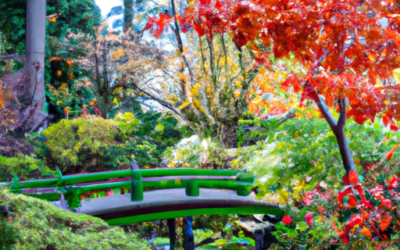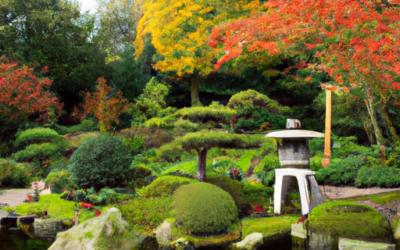Stepping into a peaceful oasis, the Portland Japanese Garden awaits you, offering a serene escape nestled within the city. This expansive and meticulously curated space is more than just a garden – it’s an authentic Japanese experience right at your doorstep. As you wander through the tranquil pathways, passing by the charm of an original tea house and over delicate bridges, stunning views of majestic Mount Hood will take your breath away. This guide equips you with a wealth of handy tips, inviting you to immerse yourself in the harmonious beauty of five different garden styles, each mirroring a facet of Japan’s rich cultural history. Get ready to marvel at a landscape of indigenous Northwest plants mingling with traditional Japanese flora, or engage in quiet reflection by the Sand and Stone Garden. Whether you’re a first-time visitor or a seasoned regular, the Portland Japanese Garden, hailed as one of the most authentic outside Japan, is a journey into tranquility that you will cherish.
The Significance of Portland Japanese Garden
Located in the picturesque West Hills of Portland, the Portland Japanese Garden is a tranquil haven of beautiful greenery and meticulously maintained landscapes. This twelve-acre haven offers an authentic Japanese tea house, calming streams, and gorgeous walkways.
Historical and cultural significance of the garden
Founded in 1963, the garden has rich historical significance. It serves as a testament to the friendship and healing built between America and Japan post World War II. As one of the most authentic Japanese gardens outside Japan, it beautifully encompasses the cultural spirit and aesthetics of traditional Japanese landscapes.
Symbol of healing post World War II
Following the traumatic events of World War II, the Portland Japanese Garden was established as a symbol of healing between former adversaries. Over the years, it has become a center for the cultural exchange and deep mutual understanding, consolidating the friendship and alliance shared between Japan and America.
Depiction of various Japanese garden styles
The tranquil space features five distinct garden styles – the Tea Garden, Strolling Pond Garden, Natural Garden, Sand and Stone Garden, and the Flat Garden. Each garden provides a contemplative space that helps you shed your worldly worries and immerse yourself in the rich experiences offered by each garden type.
Exploring the Gardens
Quiet contemplation in the Sand and Stone Garden
The Sand and Stone Garden, designed before Zen Buddhism became popular in the U.S., invites contemplation with its elemental focus on sand and stone. Here, you can find peace and introspection among the carefully placed rocks and raked sand patterns.
Strolling through the Pond Garden
The Strolling Pond Garden embodies the wealth of the landscape with a zigzagging bridge leading through beds of Japanese iris beside a cascading waterfall. The pond’s serenity underscores the tranquil beauty of this garden type.
Experiencing harmony in the Natural Garden
A stroll through the Natural Garden lets you experience the harmony and balance characteristic of traditional Japanese gardens. Its prominent feature – the Pacific Northwest vine maple – is strategically placed to highlight the four beautiful seasons.
The serenity of the Flat Garden
Reminiscent of a peaceful landscape painting, the Flat Garden combines various elements, creating a serene tableau that changes with the seasons. Here, lush azalea shrubs and delicate lace-leaf maple trees paint a quiet and calming scenery.
The Cultural Crossing Expansion
The massive undertaking
The Cultural Crossing Expansion, completed in 2017, enhances the garden’s physical and cultural landscape. It stands as the garden’s first-ever upgrade since its opening, marking a significant milestone.
LEED-certified buildings and new garden spaces
The expansion boasts of LEED-certified buildings, promoting energy and environmental design. It also invites exploration of seven new garden spaces, each offering a unique experience.
Purpose and impact of the expansion
With the goal of wider cultural education and to ensure the garden’s tranquillity remains undisturbed, the expansion further enhances the visitor’s experience, preserving the authenticity of the garden, and expanding its teachings about Japanese culture.
The Unique Flora of Portland Japanese Garden
Variety of plants and trees
Among the majestic cedar and pine trees, you’ll find a variety of Pacific Northwest native Japanese plants and shrubs, including cherries, dogwoods, maples, azaleas, wisteria, and many others.
Role of Pacific Northwest native vine maple
The Pacific Northwest native vine maple is a standout, deliberately placed to showcase the sublime transformation through all seasons.
Significance of the plants in Japanese culture
Many of the flora species found within the garden hold specific cultural significance in Japan. For example, azaleas and maples symbolize endurance and preservation in Japanese culture, underscoring their symbolic importance within the garden.
Visiting the Cultural Village
What to expect
The Cultural Village presents an exploration of Japanese heritage through art, nature, and architecture. With traditional structures, like the authentic tea house, it encourages immersive learning about Japanese culture.
The Umami Café
A visit to the garden wouldn’t be complete without stopping by the Umami Café, where you can enjoy traditional Japanese teas and pastries amidst the landscape’s tranquillity.
The Jordan Schnitzer Japanese Arts Learning Center
The Jordan Schnitzer Japanese Arts Learning Center serves to deepen understanding and appreciation of Japanese art and culture, with regular exhibitions, workshops, and seminars in its Tanabe Gallery.
Guided Tours and Special Events
Inclusions in the tour
Guided tours are included with the cost of admission, offering deeper insights into the garden’s history, styles, flora and fauna, and cultural significance.
Popular events like autumn moon-viewing nights
Among the garden’s most popular events are the autumn moon-viewing nights, where visitors can enjoy live music, traditional tea, sake service, and seasonal Japanese foods under a moon-illuminated sky.
Availability and pricing of guided tours
Guided tours are available upon the cost of admission. You should check the Portland Japanese Garden’s website for the latest information regarding tour pricing and schedules.
Practical Information for Visitors
Current admission fees
Admission to the Portland Japanese Garden is $21.95 for adults, $18.95 for seniors, and $15.95 for youths. Details may change, so it’s recommended to always check their website for the most updated details.
Operating hours
The garden operates from Wednesday to Monday, 10 a.m. to 6 p.m., and is closed on Tuesdays.
Ideal duration of visit
Most visitors spend approximately one and a half to two hours exploring the gardens, although you’re welcome to spend as much time as you need to fully immerse yourself in the gardens’ tranquil beauty.
Accessibility information for wheelchairs and strollers
While parts of the garden are inaccessible for wheelchairs and strollers because of the natural terrain, several garden spaces such as the Flat Garden, Sand and Stone Garden, Cultural Village, and others provide accessibility for all visitors.
Tips for Visiting Portland Japanese Garden
Best time to visit
Though the garden’s beauty persists year-round, the best times to visit are spring when cherry blossoms fill the air and autumn when the garden is ablaze with fiery fall colors.
What to wear and bring
Wear comfortable shoes suitable for walking through garden paths. Keep in mind the changeable Portland weather, and consider bringing a light raincoat or umbrella.
Parking and public transportation options
Parking can be a challenge, so consider utilizing public transit options like TriMet bus or MAX train. The Explore Washington Park shuttle also offers easy access to the garden.
Nearby Attractions and Neighborhoods
The scenic West Hills
Enjoy panoramic views of the city from the elevated West Hills area, which is also home to the Pittock Mansion and Hoyt Arboretum.
International Rose Test Garden
Close to the Japanese Garden is the International Rose Test Garden, showcasing thousands of rose varieties in bloom from April through October.
Other attractions in Washington Park
Explore the numerous attractions within Washington Park, including the Oregon Zoo, Children’s Museum, and the World Forestry Center.
Immerse in Japanese American Culture in Portland
Introduction to Portland’s rich Japanese-American heritage
With its deep and rich Japanese-American heritage, Portland offers countless ways to immerse in the culture, from its cuisine to its art scene.
Places around the city that reflect Japanese culture
Several places around the city reflect Japanese culture notably. Explore the numerous sushi bars, ramen shops, and artisan sake producers, besides the art galleries featuring Japanese arts and crafts.
Integration of Japanese culture in Portland
From traditional tea ceremonies to the annual Japanese festivals, the integration of Japanese culture into the fabric of Portland life is profound and extensive, offering numerous opportunities to explore and appreciate it.








